PPMP20011: Consolidated Portfolio on Commercial Project Negotiation
VerifiedAdded on 2024/06/03
|20
|3513
|315
Portfolio
AI Summary
This consolidated portfolio examines commercial project negotiation, focusing on diverse government and non-government project contractual arrangements, stakeholder agendas, and conflict management methods. It differentiates negotiation techniques across varying technology standards and asset lifecycles, explaining methods for reconciling conflicting objectives and managing stakeholder relationships. The portfolio also addresses the consequences of project delays, variations, and methods for claims, liquidated damages, and arbitration. Furthermore, it evaluates project management tools for conflict resolution, providing a comprehensive overview of key aspects in commercial project negotiation. Desklib offers a wealth of study resources, including solved assignments and past papers, to aid students in their academic pursuits.
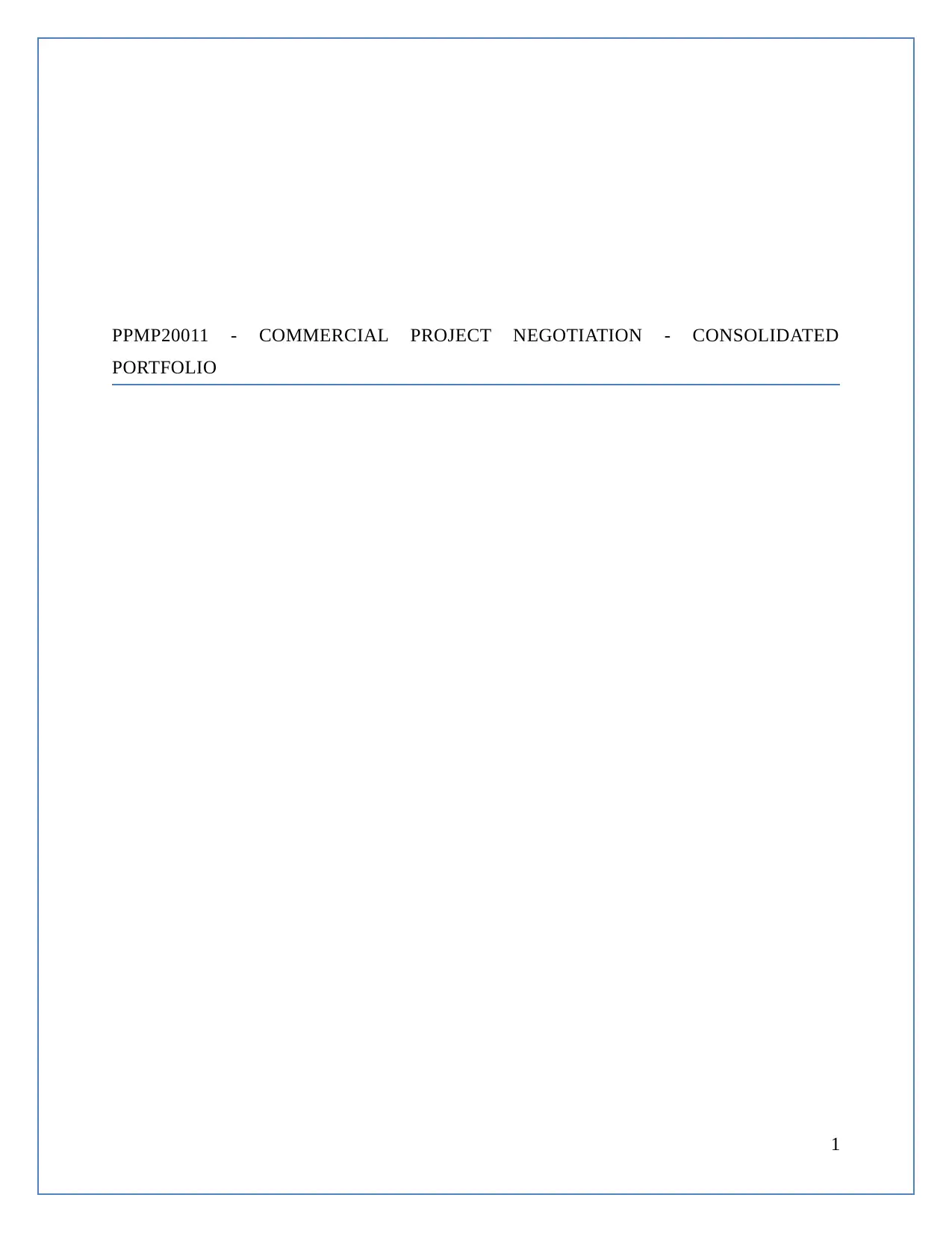
PPMP20011 - COMMERCIAL PROJECT NEGOTIATION - CONSOLIDATED
PORTFOLIO
1
PORTFOLIO
1
Paraphrase This Document
Need a fresh take? Get an instant paraphrase of this document with our AI Paraphraser
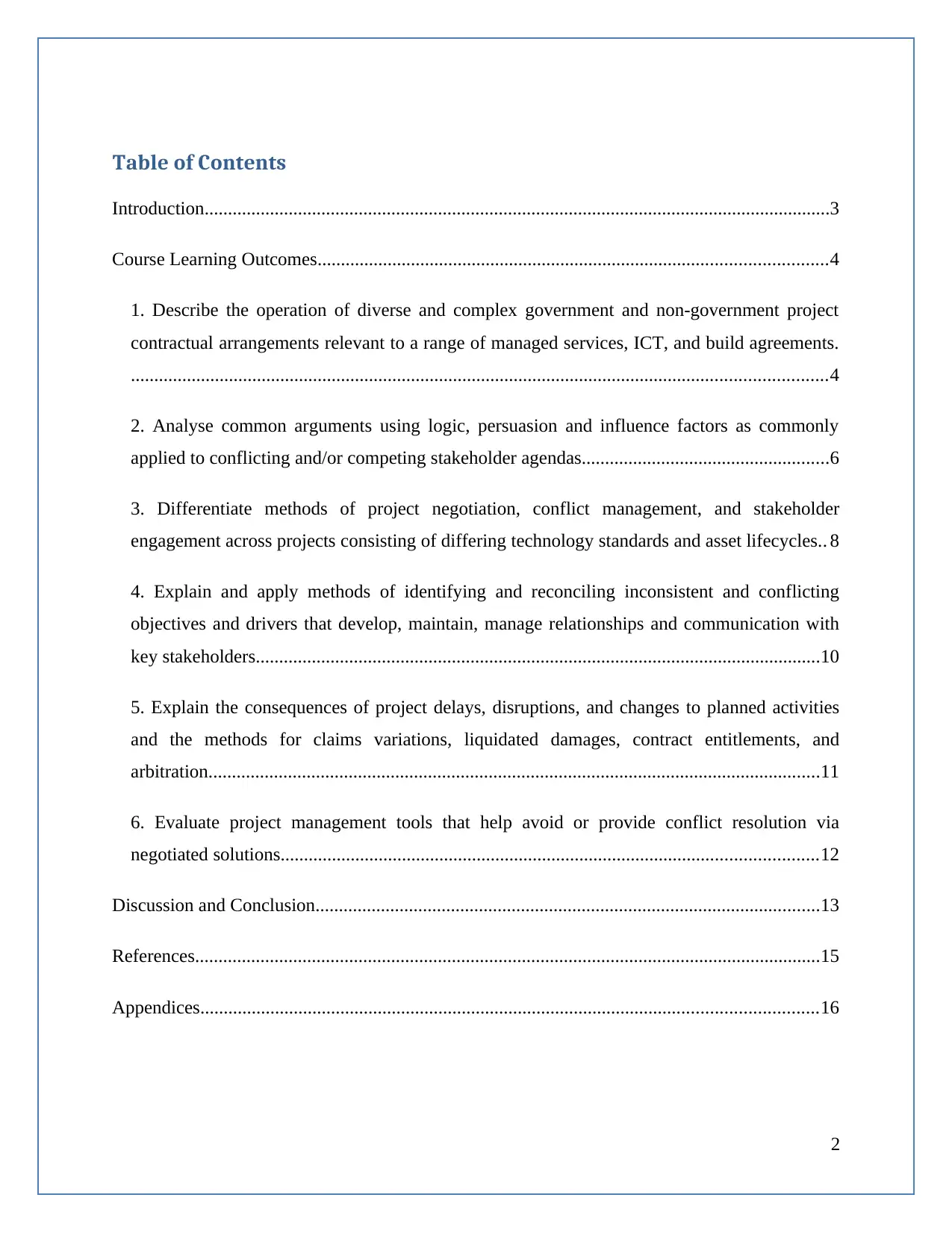
Table of Contents
Introduction......................................................................................................................................3
Course Learning Outcomes.............................................................................................................4
1. Describe the operation of diverse and complex government and non-government project
contractual arrangements relevant to a range of managed services, ICT, and build agreements.
.....................................................................................................................................................4
2. Analyse common arguments using logic, persuasion and influence factors as commonly
applied to conflicting and/or competing stakeholder agendas.....................................................6
3. Differentiate methods of project negotiation, conflict management, and stakeholder
engagement across projects consisting of differing technology standards and asset lifecycles.. 8
4. Explain and apply methods of identifying and reconciling inconsistent and conflicting
objectives and drivers that develop, maintain, manage relationships and communication with
key stakeholders.........................................................................................................................10
5. Explain the consequences of project delays, disruptions, and changes to planned activities
and the methods for claims variations, liquidated damages, contract entitlements, and
arbitration...................................................................................................................................11
6. Evaluate project management tools that help avoid or provide conflict resolution via
negotiated solutions...................................................................................................................12
Discussion and Conclusion............................................................................................................13
References......................................................................................................................................15
Appendices....................................................................................................................................16
2
Introduction......................................................................................................................................3
Course Learning Outcomes.............................................................................................................4
1. Describe the operation of diverse and complex government and non-government project
contractual arrangements relevant to a range of managed services, ICT, and build agreements.
.....................................................................................................................................................4
2. Analyse common arguments using logic, persuasion and influence factors as commonly
applied to conflicting and/or competing stakeholder agendas.....................................................6
3. Differentiate methods of project negotiation, conflict management, and stakeholder
engagement across projects consisting of differing technology standards and asset lifecycles.. 8
4. Explain and apply methods of identifying and reconciling inconsistent and conflicting
objectives and drivers that develop, maintain, manage relationships and communication with
key stakeholders.........................................................................................................................10
5. Explain the consequences of project delays, disruptions, and changes to planned activities
and the methods for claims variations, liquidated damages, contract entitlements, and
arbitration...................................................................................................................................11
6. Evaluate project management tools that help avoid or provide conflict resolution via
negotiated solutions...................................................................................................................12
Discussion and Conclusion............................................................................................................13
References......................................................................................................................................15
Appendices....................................................................................................................................16
2
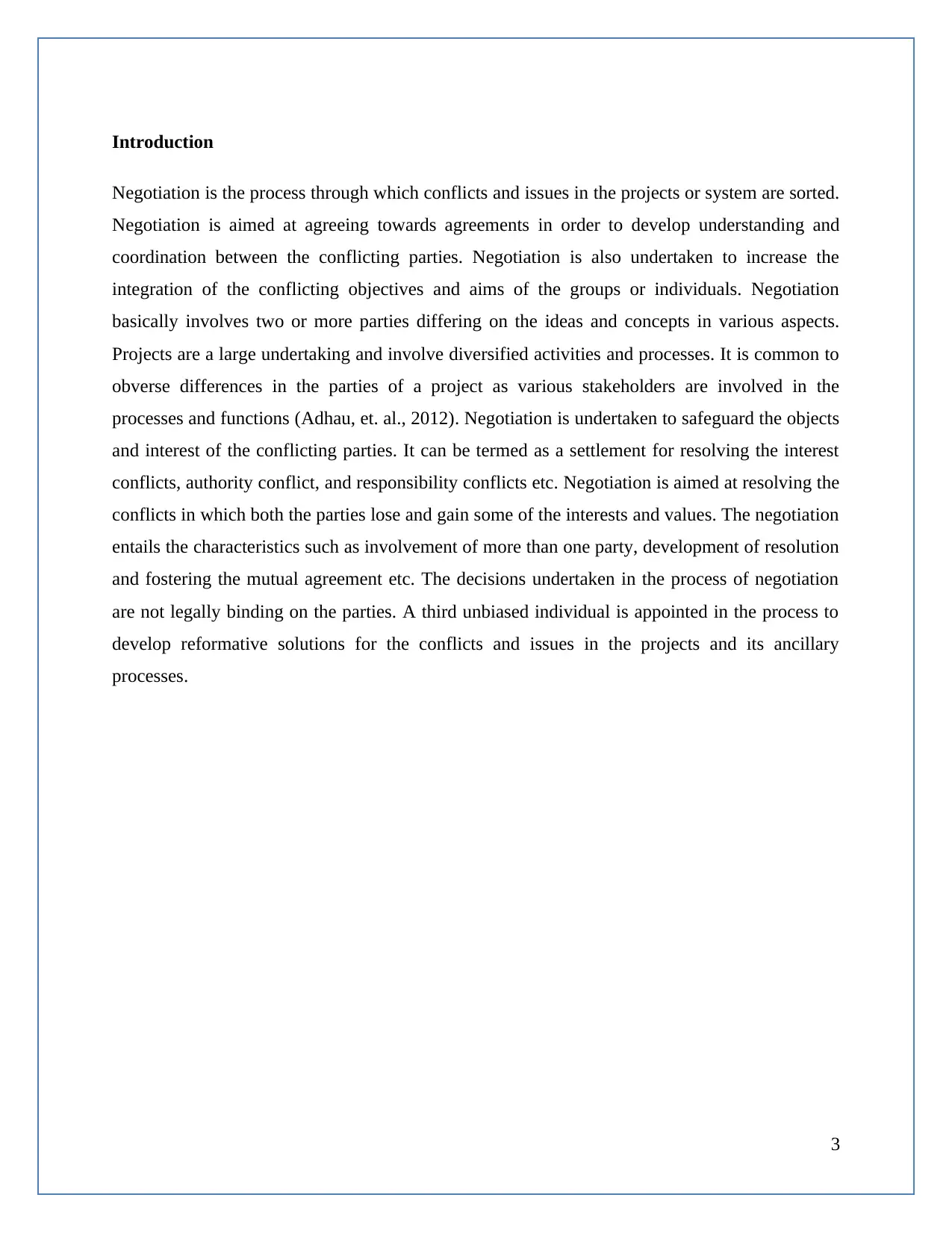
Introduction
Negotiation is the process through which conflicts and issues in the projects or system are sorted.
Negotiation is aimed at agreeing towards agreements in order to develop understanding and
coordination between the conflicting parties. Negotiation is also undertaken to increase the
integration of the conflicting objectives and aims of the groups or individuals. Negotiation
basically involves two or more parties differing on the ideas and concepts in various aspects.
Projects are a large undertaking and involve diversified activities and processes. It is common to
obverse differences in the parties of a project as various stakeholders are involved in the
processes and functions (Adhau, et. al., 2012). Negotiation is undertaken to safeguard the objects
and interest of the conflicting parties. It can be termed as a settlement for resolving the interest
conflicts, authority conflict, and responsibility conflicts etc. Negotiation is aimed at resolving the
conflicts in which both the parties lose and gain some of the interests and values. The negotiation
entails the characteristics such as involvement of more than one party, development of resolution
and fostering the mutual agreement etc. The decisions undertaken in the process of negotiation
are not legally binding on the parties. A third unbiased individual is appointed in the process to
develop reformative solutions for the conflicts and issues in the projects and its ancillary
processes.
3
Negotiation is the process through which conflicts and issues in the projects or system are sorted.
Negotiation is aimed at agreeing towards agreements in order to develop understanding and
coordination between the conflicting parties. Negotiation is also undertaken to increase the
integration of the conflicting objectives and aims of the groups or individuals. Negotiation
basically involves two or more parties differing on the ideas and concepts in various aspects.
Projects are a large undertaking and involve diversified activities and processes. It is common to
obverse differences in the parties of a project as various stakeholders are involved in the
processes and functions (Adhau, et. al., 2012). Negotiation is undertaken to safeguard the objects
and interest of the conflicting parties. It can be termed as a settlement for resolving the interest
conflicts, authority conflict, and responsibility conflicts etc. Negotiation is aimed at resolving the
conflicts in which both the parties lose and gain some of the interests and values. The negotiation
entails the characteristics such as involvement of more than one party, development of resolution
and fostering the mutual agreement etc. The decisions undertaken in the process of negotiation
are not legally binding on the parties. A third unbiased individual is appointed in the process to
develop reformative solutions for the conflicts and issues in the projects and its ancillary
processes.
3
⊘ This is a preview!⊘
Do you want full access?
Subscribe today to unlock all pages.

Trusted by 1+ million students worldwide
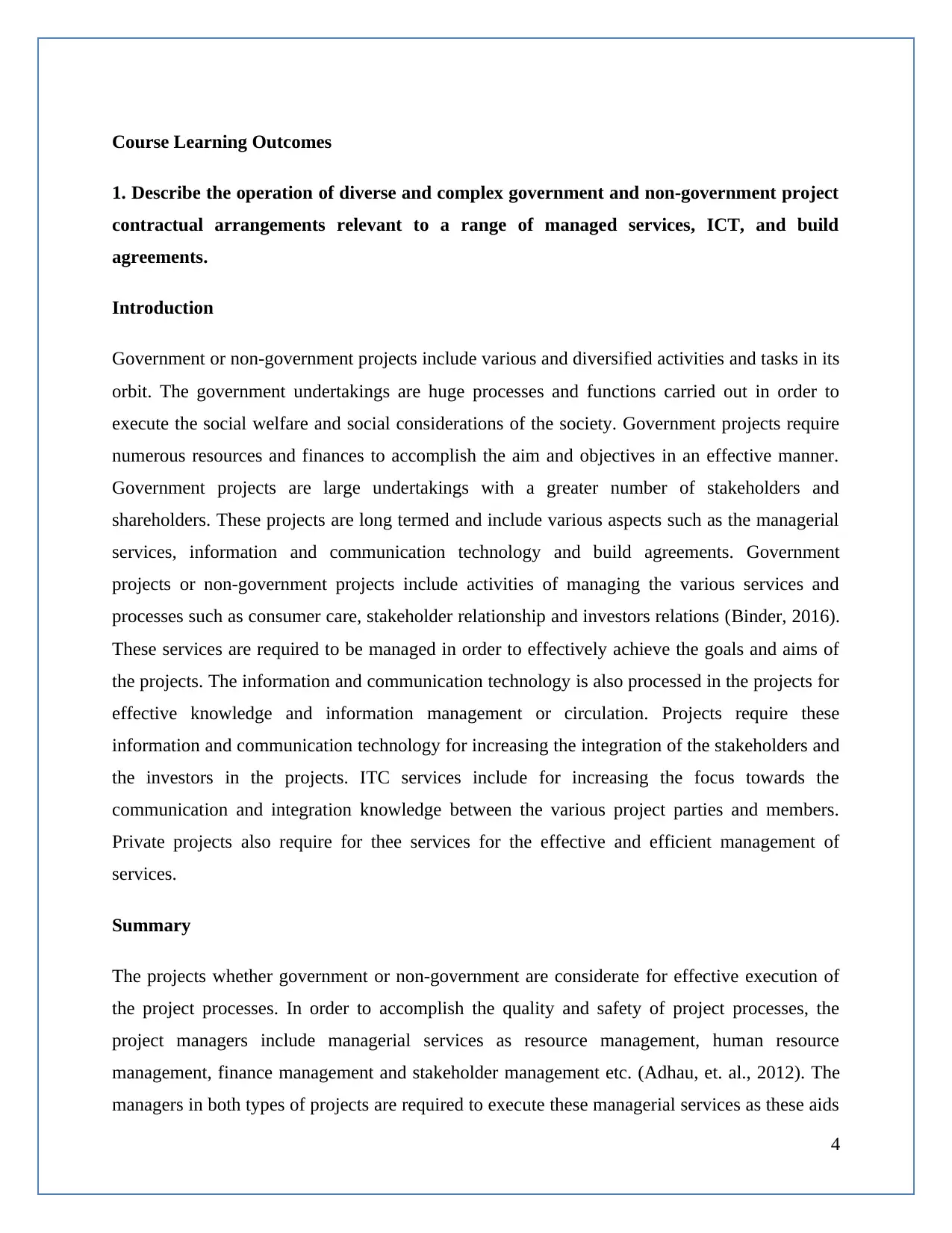
Course Learning Outcomes
1. Describe the operation of diverse and complex government and non-government project
contractual arrangements relevant to a range of managed services, ICT, and build
agreements.
Introduction
Government or non-government projects include various and diversified activities and tasks in its
orbit. The government undertakings are huge processes and functions carried out in order to
execute the social welfare and social considerations of the society. Government projects require
numerous resources and finances to accomplish the aim and objectives in an effective manner.
Government projects are large undertakings with a greater number of stakeholders and
shareholders. These projects are long termed and include various aspects such as the managerial
services, information and communication technology and build agreements. Government
projects or non-government projects include activities of managing the various services and
processes such as consumer care, stakeholder relationship and investors relations (Binder, 2016).
These services are required to be managed in order to effectively achieve the goals and aims of
the projects. The information and communication technology is also processed in the projects for
effective knowledge and information management or circulation. Projects require these
information and communication technology for increasing the integration of the stakeholders and
the investors in the projects. ITC services include for increasing the focus towards the
communication and integration knowledge between the various project parties and members.
Private projects also require for thee services for the effective and efficient management of
services.
Summary
The projects whether government or non-government are considerate for effective execution of
the project processes. In order to accomplish the quality and safety of project processes, the
project managers include managerial services as resource management, human resource
management, finance management and stakeholder management etc. (Adhau, et. al., 2012). The
managers in both types of projects are required to execute these managerial services as these aids
4
1. Describe the operation of diverse and complex government and non-government project
contractual arrangements relevant to a range of managed services, ICT, and build
agreements.
Introduction
Government or non-government projects include various and diversified activities and tasks in its
orbit. The government undertakings are huge processes and functions carried out in order to
execute the social welfare and social considerations of the society. Government projects require
numerous resources and finances to accomplish the aim and objectives in an effective manner.
Government projects are large undertakings with a greater number of stakeholders and
shareholders. These projects are long termed and include various aspects such as the managerial
services, information and communication technology and build agreements. Government
projects or non-government projects include activities of managing the various services and
processes such as consumer care, stakeholder relationship and investors relations (Binder, 2016).
These services are required to be managed in order to effectively achieve the goals and aims of
the projects. The information and communication technology is also processed in the projects for
effective knowledge and information management or circulation. Projects require these
information and communication technology for increasing the integration of the stakeholders and
the investors in the projects. ITC services include for increasing the focus towards the
communication and integration knowledge between the various project parties and members.
Private projects also require for thee services for the effective and efficient management of
services.
Summary
The projects whether government or non-government are considerate for effective execution of
the project processes. In order to accomplish the quality and safety of project processes, the
project managers include managerial services as resource management, human resource
management, finance management and stakeholder management etc. (Adhau, et. al., 2012). The
managers in both types of projects are required to execute these managerial services as these aids
4
Paraphrase This Document
Need a fresh take? Get an instant paraphrase of this document with our AI Paraphraser
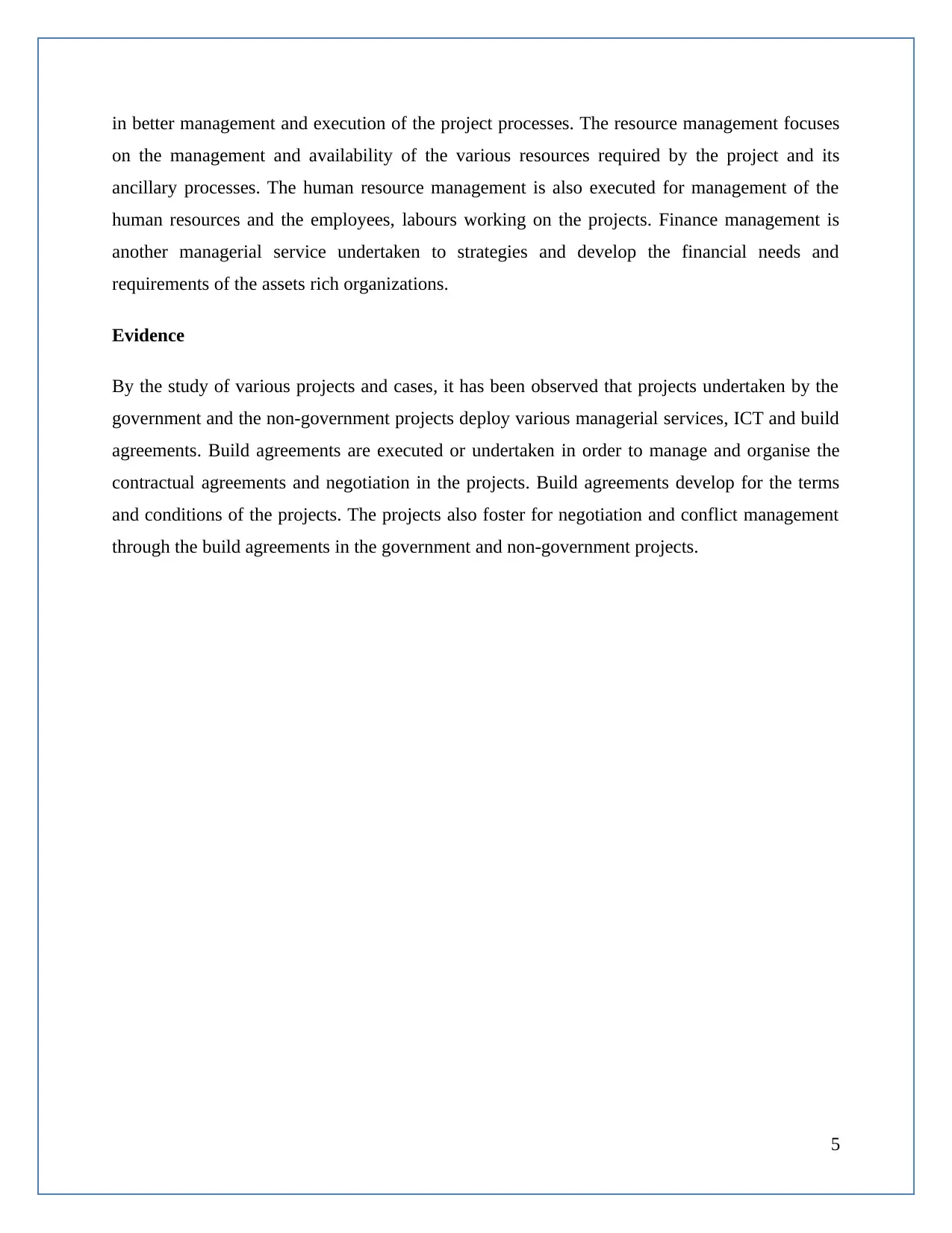
in better management and execution of the project processes. The resource management focuses
on the management and availability of the various resources required by the project and its
ancillary processes. The human resource management is also executed for management of the
human resources and the employees, labours working on the projects. Finance management is
another managerial service undertaken to strategies and develop the financial needs and
requirements of the assets rich organizations.
Evidence
By the study of various projects and cases, it has been observed that projects undertaken by the
government and the non-government projects deploy various managerial services, ICT and build
agreements. Build agreements are executed or undertaken in order to manage and organise the
contractual agreements and negotiation in the projects. Build agreements develop for the terms
and conditions of the projects. The projects also foster for negotiation and conflict management
through the build agreements in the government and non-government projects.
5
on the management and availability of the various resources required by the project and its
ancillary processes. The human resource management is also executed for management of the
human resources and the employees, labours working on the projects. Finance management is
another managerial service undertaken to strategies and develop the financial needs and
requirements of the assets rich organizations.
Evidence
By the study of various projects and cases, it has been observed that projects undertaken by the
government and the non-government projects deploy various managerial services, ICT and build
agreements. Build agreements are executed or undertaken in order to manage and organise the
contractual agreements and negotiation in the projects. Build agreements develop for the terms
and conditions of the projects. The projects also foster for negotiation and conflict management
through the build agreements in the government and non-government projects.
5
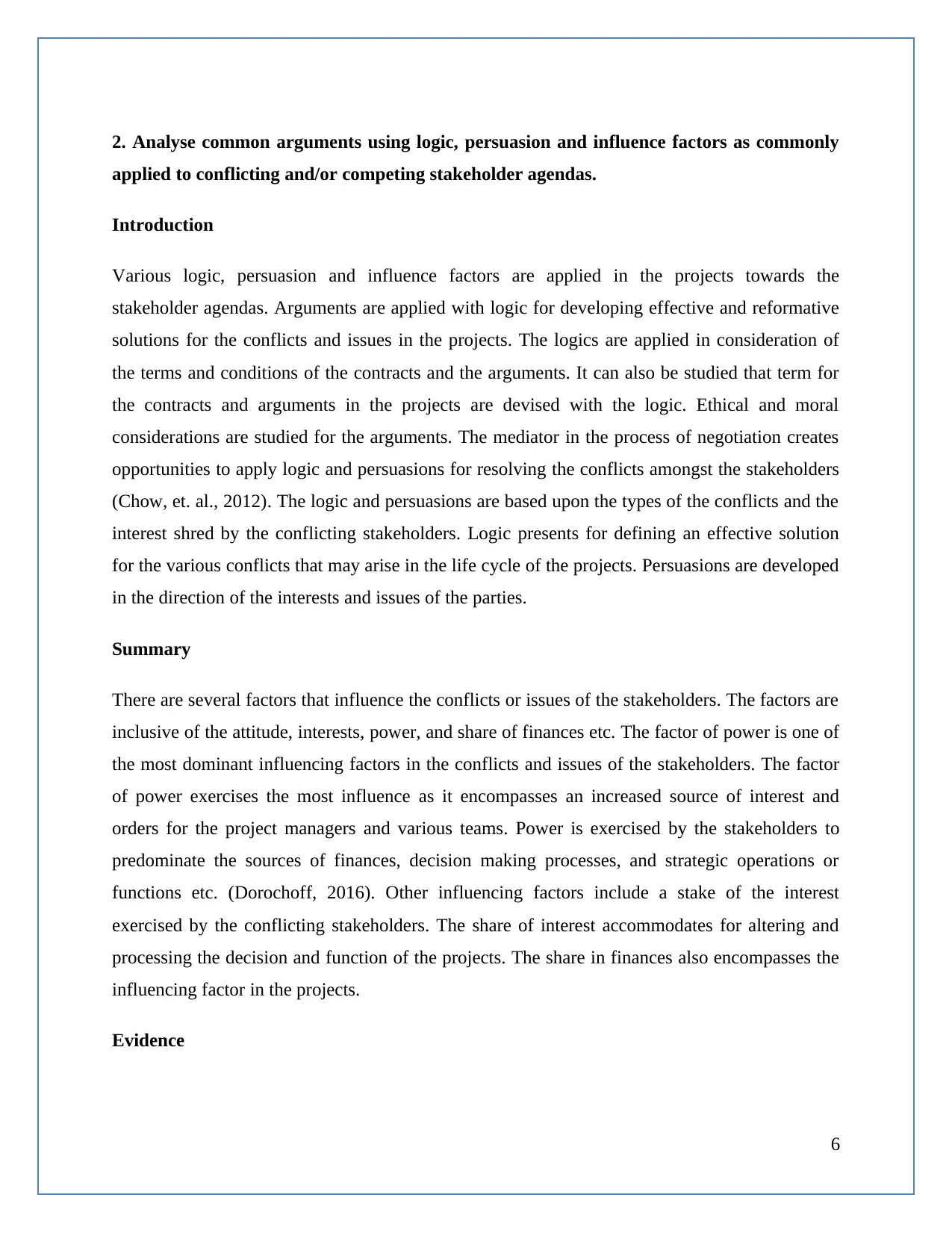
2. Analyse common arguments using logic, persuasion and influence factors as commonly
applied to conflicting and/or competing stakeholder agendas.
Introduction
Various logic, persuasion and influence factors are applied in the projects towards the
stakeholder agendas. Arguments are applied with logic for developing effective and reformative
solutions for the conflicts and issues in the projects. The logics are applied in consideration of
the terms and conditions of the contracts and the arguments. It can also be studied that term for
the contracts and arguments in the projects are devised with the logic. Ethical and moral
considerations are studied for the arguments. The mediator in the process of negotiation creates
opportunities to apply logic and persuasions for resolving the conflicts amongst the stakeholders
(Chow, et. al., 2012). The logic and persuasions are based upon the types of the conflicts and the
interest shred by the conflicting stakeholders. Logic presents for defining an effective solution
for the various conflicts that may arise in the life cycle of the projects. Persuasions are developed
in the direction of the interests and issues of the parties.
Summary
There are several factors that influence the conflicts or issues of the stakeholders. The factors are
inclusive of the attitude, interests, power, and share of finances etc. The factor of power is one of
the most dominant influencing factors in the conflicts and issues of the stakeholders. The factor
of power exercises the most influence as it encompasses an increased source of interest and
orders for the project managers and various teams. Power is exercised by the stakeholders to
predominate the sources of finances, decision making processes, and strategic operations or
functions etc. (Dorochoff, 2016). Other influencing factors include a stake of the interest
exercised by the conflicting stakeholders. The share of interest accommodates for altering and
processing the decision and function of the projects. The share in finances also encompasses the
influencing factor in the projects.
Evidence
6
applied to conflicting and/or competing stakeholder agendas.
Introduction
Various logic, persuasion and influence factors are applied in the projects towards the
stakeholder agendas. Arguments are applied with logic for developing effective and reformative
solutions for the conflicts and issues in the projects. The logics are applied in consideration of
the terms and conditions of the contracts and the arguments. It can also be studied that term for
the contracts and arguments in the projects are devised with the logic. Ethical and moral
considerations are studied for the arguments. The mediator in the process of negotiation creates
opportunities to apply logic and persuasions for resolving the conflicts amongst the stakeholders
(Chow, et. al., 2012). The logic and persuasions are based upon the types of the conflicts and the
interest shred by the conflicting stakeholders. Logic presents for defining an effective solution
for the various conflicts that may arise in the life cycle of the projects. Persuasions are developed
in the direction of the interests and issues of the parties.
Summary
There are several factors that influence the conflicts or issues of the stakeholders. The factors are
inclusive of the attitude, interests, power, and share of finances etc. The factor of power is one of
the most dominant influencing factors in the conflicts and issues of the stakeholders. The factor
of power exercises the most influence as it encompasses an increased source of interest and
orders for the project managers and various teams. Power is exercised by the stakeholders to
predominate the sources of finances, decision making processes, and strategic operations or
functions etc. (Dorochoff, 2016). Other influencing factors include a stake of the interest
exercised by the conflicting stakeholders. The share of interest accommodates for altering and
processing the decision and function of the projects. The share in finances also encompasses the
influencing factor in the projects.
Evidence
6
⊘ This is a preview!⊘
Do you want full access?
Subscribe today to unlock all pages.

Trusted by 1+ million students worldwide

The logic for creating the decisions and processes in the projects are based upon the ethical,
moral and conditions of the projects. The logic in the cases of conflicts and issues in the projects
are undertaken according to the pre-defined terms and conditions of the projects. The logic
considers the ethical considerations to be processed in order to form for resolutions for conflicts
and issues in the projects.
7
moral and conditions of the projects. The logic in the cases of conflicts and issues in the projects
are undertaken according to the pre-defined terms and conditions of the projects. The logic
considers the ethical considerations to be processed in order to form for resolutions for conflicts
and issues in the projects.
7
Paraphrase This Document
Need a fresh take? Get an instant paraphrase of this document with our AI Paraphraser
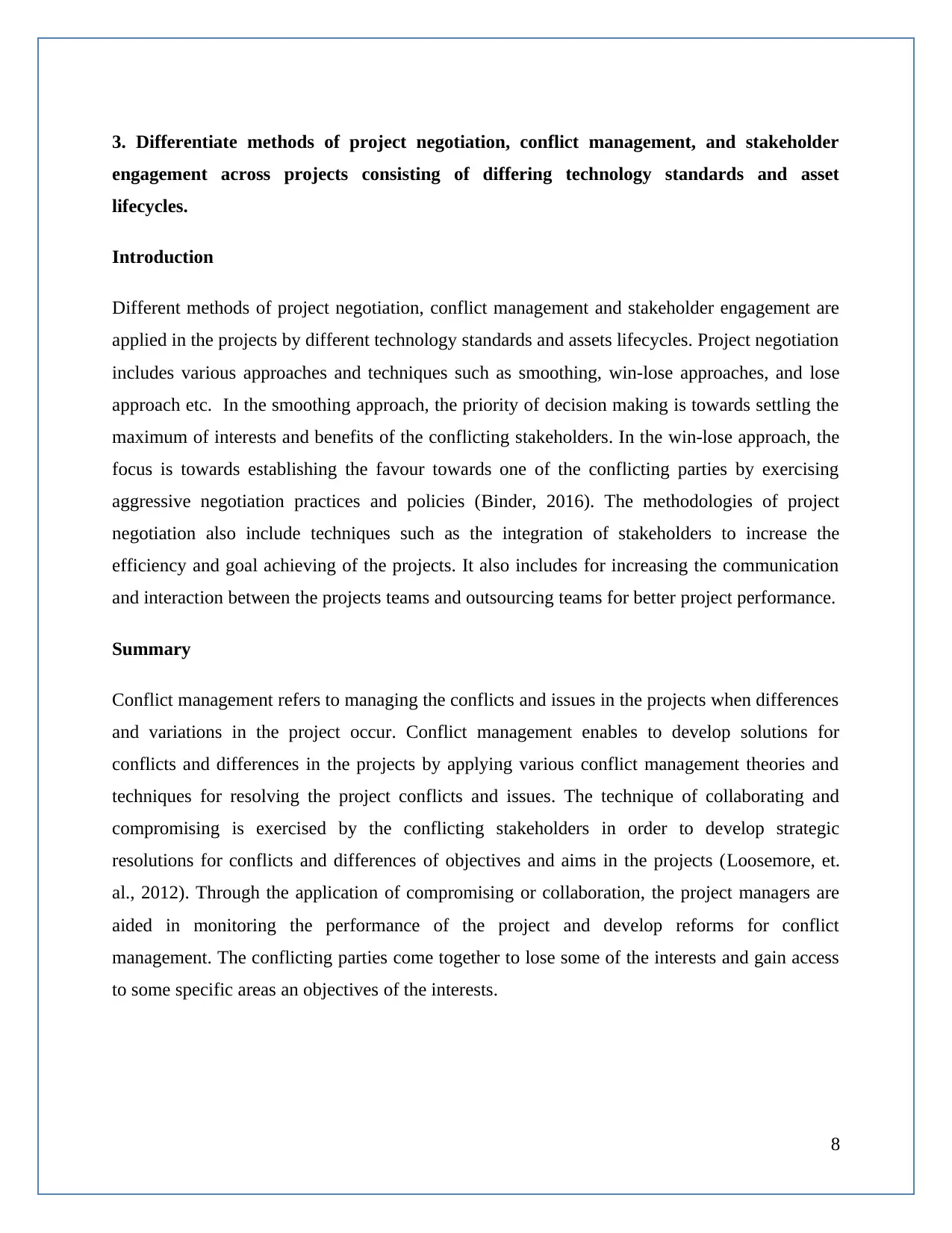
3. Differentiate methods of project negotiation, conflict management, and stakeholder
engagement across projects consisting of differing technology standards and asset
lifecycles.
Introduction
Different methods of project negotiation, conflict management and stakeholder engagement are
applied in the projects by different technology standards and assets lifecycles. Project negotiation
includes various approaches and techniques such as smoothing, win-lose approaches, and lose
approach etc. In the smoothing approach, the priority of decision making is towards settling the
maximum of interests and benefits of the conflicting stakeholders. In the win-lose approach, the
focus is towards establishing the favour towards one of the conflicting parties by exercising
aggressive negotiation practices and policies (Binder, 2016). The methodologies of project
negotiation also include techniques such as the integration of stakeholders to increase the
efficiency and goal achieving of the projects. It also includes for increasing the communication
and interaction between the projects teams and outsourcing teams for better project performance.
Summary
Conflict management refers to managing the conflicts and issues in the projects when differences
and variations in the project occur. Conflict management enables to develop solutions for
conflicts and differences in the projects by applying various conflict management theories and
techniques for resolving the project conflicts and issues. The technique of collaborating and
compromising is exercised by the conflicting stakeholders in order to develop strategic
resolutions for conflicts and differences of objectives and aims in the projects (Loosemore, et.
al., 2012). Through the application of compromising or collaboration, the project managers are
aided in monitoring the performance of the project and develop reforms for conflict
management. The conflicting parties come together to lose some of the interests and gain access
to some specific areas an objectives of the interests.
8
engagement across projects consisting of differing technology standards and asset
lifecycles.
Introduction
Different methods of project negotiation, conflict management and stakeholder engagement are
applied in the projects by different technology standards and assets lifecycles. Project negotiation
includes various approaches and techniques such as smoothing, win-lose approaches, and lose
approach etc. In the smoothing approach, the priority of decision making is towards settling the
maximum of interests and benefits of the conflicting stakeholders. In the win-lose approach, the
focus is towards establishing the favour towards one of the conflicting parties by exercising
aggressive negotiation practices and policies (Binder, 2016). The methodologies of project
negotiation also include techniques such as the integration of stakeholders to increase the
efficiency and goal achieving of the projects. It also includes for increasing the communication
and interaction between the projects teams and outsourcing teams for better project performance.
Summary
Conflict management refers to managing the conflicts and issues in the projects when differences
and variations in the project occur. Conflict management enables to develop solutions for
conflicts and differences in the projects by applying various conflict management theories and
techniques for resolving the project conflicts and issues. The technique of collaborating and
compromising is exercised by the conflicting stakeholders in order to develop strategic
resolutions for conflicts and differences of objectives and aims in the projects (Loosemore, et.
al., 2012). Through the application of compromising or collaboration, the project managers are
aided in monitoring the performance of the project and develop reforms for conflict
management. The conflicting parties come together to lose some of the interests and gain access
to some specific areas an objectives of the interests.
8
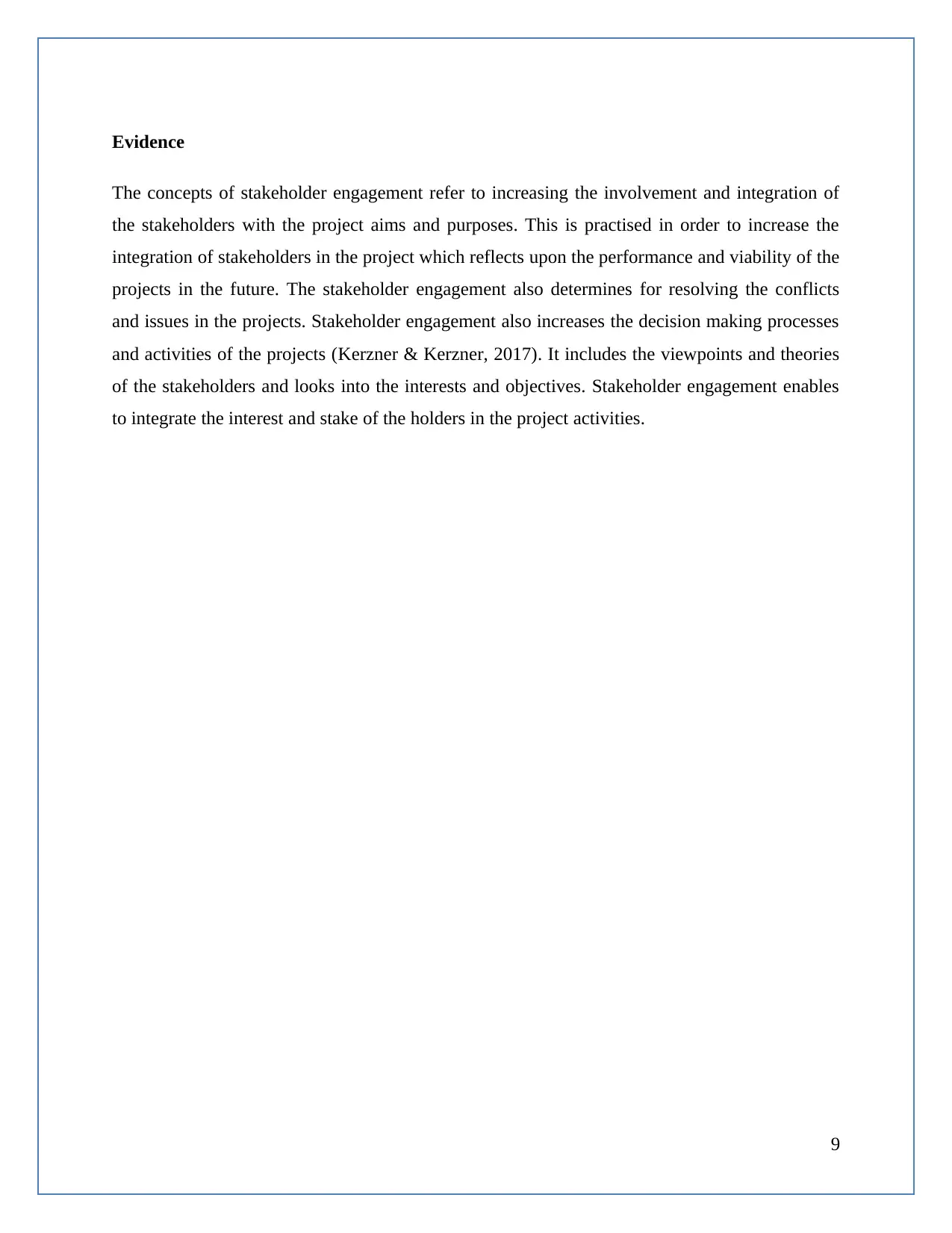
Evidence
The concepts of stakeholder engagement refer to increasing the involvement and integration of
the stakeholders with the project aims and purposes. This is practised in order to increase the
integration of stakeholders in the project which reflects upon the performance and viability of the
projects in the future. The stakeholder engagement also determines for resolving the conflicts
and issues in the projects. Stakeholder engagement also increases the decision making processes
and activities of the projects (Kerzner & Kerzner, 2017). It includes the viewpoints and theories
of the stakeholders and looks into the interests and objectives. Stakeholder engagement enables
to integrate the interest and stake of the holders in the project activities.
9
The concepts of stakeholder engagement refer to increasing the involvement and integration of
the stakeholders with the project aims and purposes. This is practised in order to increase the
integration of stakeholders in the project which reflects upon the performance and viability of the
projects in the future. The stakeholder engagement also determines for resolving the conflicts
and issues in the projects. Stakeholder engagement also increases the decision making processes
and activities of the projects (Kerzner & Kerzner, 2017). It includes the viewpoints and theories
of the stakeholders and looks into the interests and objectives. Stakeholder engagement enables
to integrate the interest and stake of the holders in the project activities.
9
⊘ This is a preview!⊘
Do you want full access?
Subscribe today to unlock all pages.

Trusted by 1+ million students worldwide
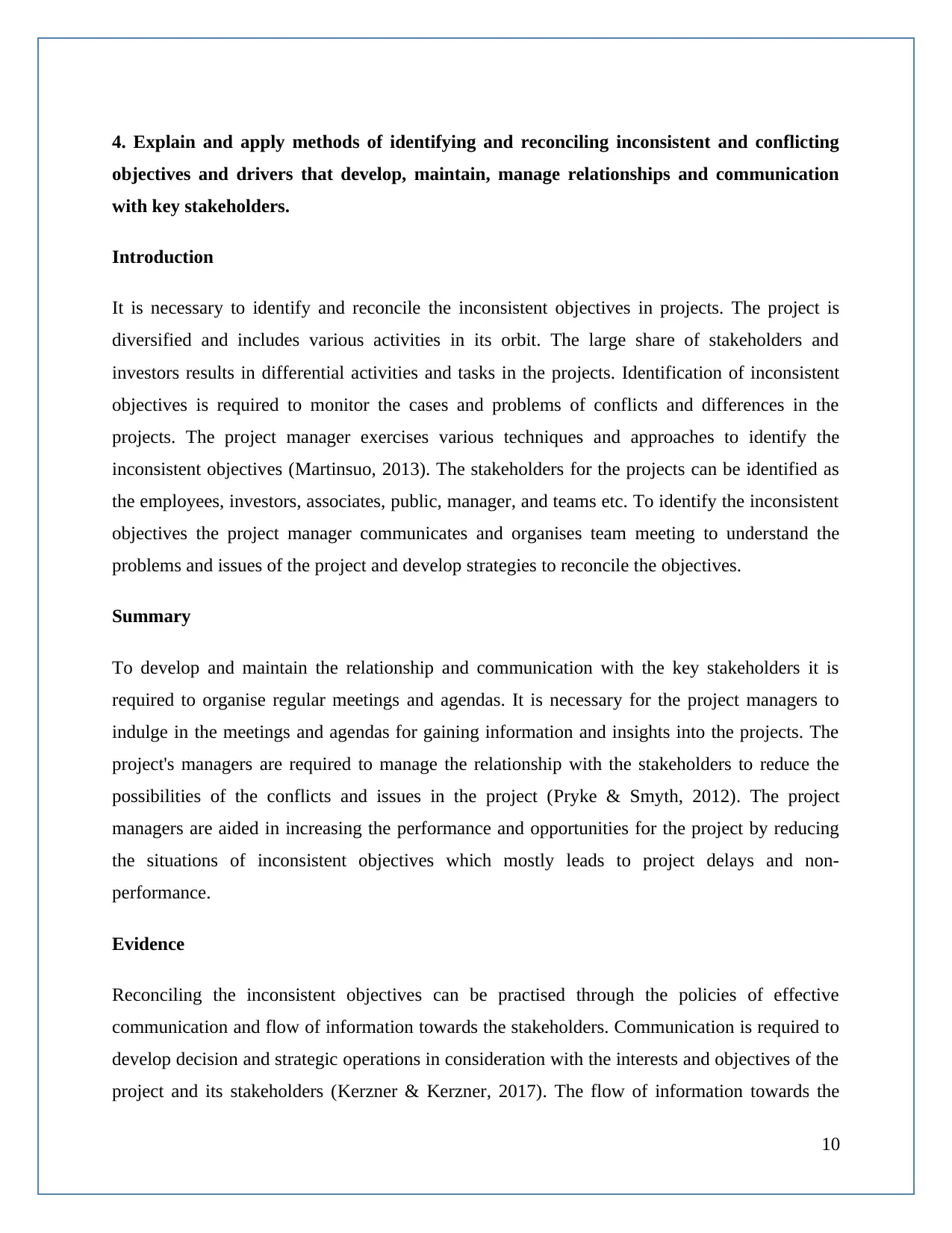
4. Explain and apply methods of identifying and reconciling inconsistent and conflicting
objectives and drivers that develop, maintain, manage relationships and communication
with key stakeholders.
Introduction
It is necessary to identify and reconcile the inconsistent objectives in projects. The project is
diversified and includes various activities in its orbit. The large share of stakeholders and
investors results in differential activities and tasks in the projects. Identification of inconsistent
objectives is required to monitor the cases and problems of conflicts and differences in the
projects. The project manager exercises various techniques and approaches to identify the
inconsistent objectives (Martinsuo, 2013). The stakeholders for the projects can be identified as
the employees, investors, associates, public, manager, and teams etc. To identify the inconsistent
objectives the project manager communicates and organises team meeting to understand the
problems and issues of the project and develop strategies to reconcile the objectives.
Summary
To develop and maintain the relationship and communication with the key stakeholders it is
required to organise regular meetings and agendas. It is necessary for the project managers to
indulge in the meetings and agendas for gaining information and insights into the projects. The
project's managers are required to manage the relationship with the stakeholders to reduce the
possibilities of the conflicts and issues in the project (Pryke & Smyth, 2012). The project
managers are aided in increasing the performance and opportunities for the project by reducing
the situations of inconsistent objectives which mostly leads to project delays and non-
performance.
Evidence
Reconciling the inconsistent objectives can be practised through the policies of effective
communication and flow of information towards the stakeholders. Communication is required to
develop decision and strategic operations in consideration with the interests and objectives of the
project and its stakeholders (Kerzner & Kerzner, 2017). The flow of information towards the
10
objectives and drivers that develop, maintain, manage relationships and communication
with key stakeholders.
Introduction
It is necessary to identify and reconcile the inconsistent objectives in projects. The project is
diversified and includes various activities in its orbit. The large share of stakeholders and
investors results in differential activities and tasks in the projects. Identification of inconsistent
objectives is required to monitor the cases and problems of conflicts and differences in the
projects. The project manager exercises various techniques and approaches to identify the
inconsistent objectives (Martinsuo, 2013). The stakeholders for the projects can be identified as
the employees, investors, associates, public, manager, and teams etc. To identify the inconsistent
objectives the project manager communicates and organises team meeting to understand the
problems and issues of the project and develop strategies to reconcile the objectives.
Summary
To develop and maintain the relationship and communication with the key stakeholders it is
required to organise regular meetings and agendas. It is necessary for the project managers to
indulge in the meetings and agendas for gaining information and insights into the projects. The
project's managers are required to manage the relationship with the stakeholders to reduce the
possibilities of the conflicts and issues in the project (Pryke & Smyth, 2012). The project
managers are aided in increasing the performance and opportunities for the project by reducing
the situations of inconsistent objectives which mostly leads to project delays and non-
performance.
Evidence
Reconciling the inconsistent objectives can be practised through the policies of effective
communication and flow of information towards the stakeholders. Communication is required to
develop decision and strategic operations in consideration with the interests and objectives of the
project and its stakeholders (Kerzner & Kerzner, 2017). The flow of information towards the
10
Paraphrase This Document
Need a fresh take? Get an instant paraphrase of this document with our AI Paraphraser

stakeholders keeps them informed and educated about the changes and alterations in the project
which reduces the chances of conflicts.
11
which reduces the chances of conflicts.
11
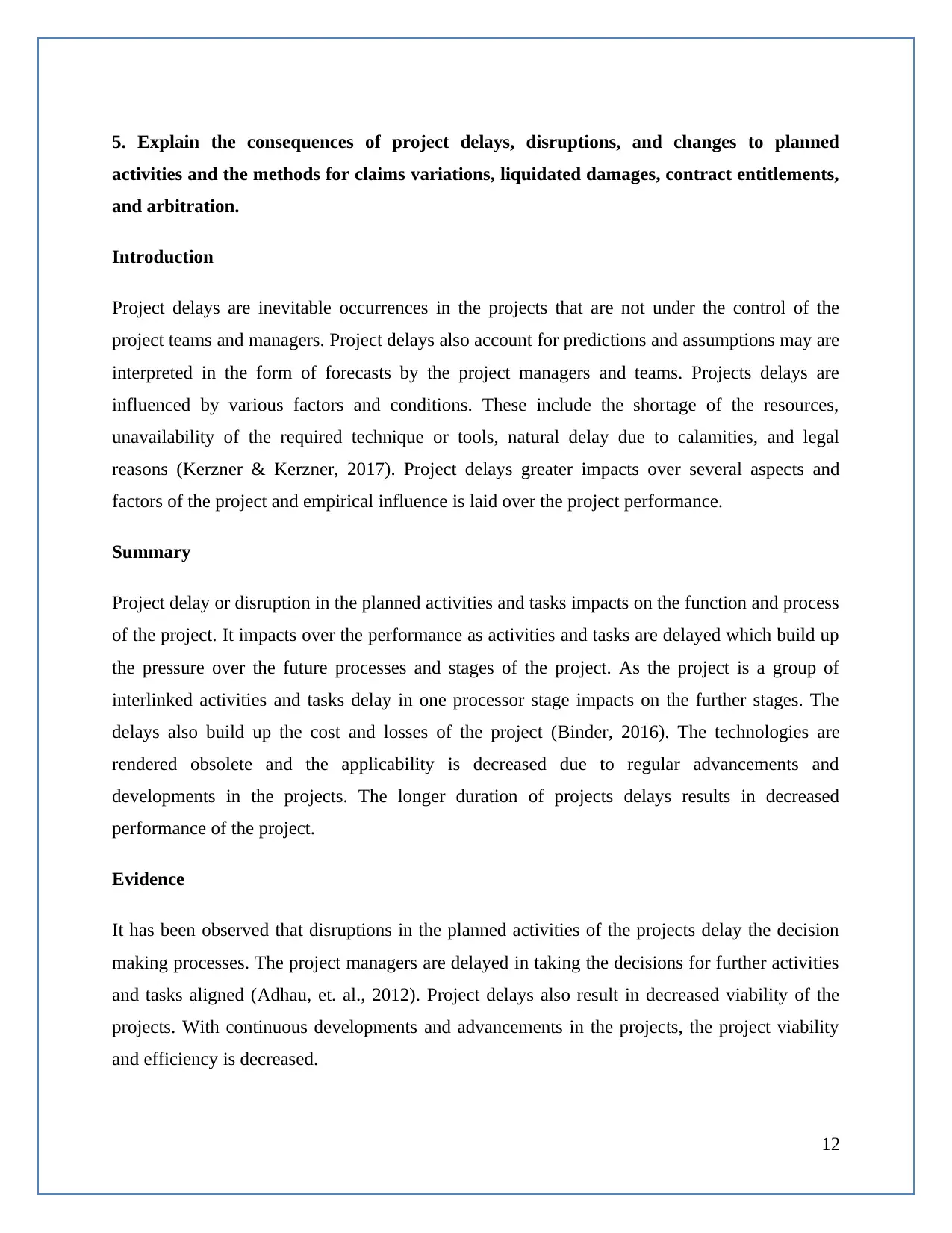
5. Explain the consequences of project delays, disruptions, and changes to planned
activities and the methods for claims variations, liquidated damages, contract entitlements,
and arbitration.
Introduction
Project delays are inevitable occurrences in the projects that are not under the control of the
project teams and managers. Project delays also account for predictions and assumptions may are
interpreted in the form of forecasts by the project managers and teams. Projects delays are
influenced by various factors and conditions. These include the shortage of the resources,
unavailability of the required technique or tools, natural delay due to calamities, and legal
reasons (Kerzner & Kerzner, 2017). Project delays greater impacts over several aspects and
factors of the project and empirical influence is laid over the project performance.
Summary
Project delay or disruption in the planned activities and tasks impacts on the function and process
of the project. It impacts over the performance as activities and tasks are delayed which build up
the pressure over the future processes and stages of the project. As the project is a group of
interlinked activities and tasks delay in one processor stage impacts on the further stages. The
delays also build up the cost and losses of the project (Binder, 2016). The technologies are
rendered obsolete and the applicability is decreased due to regular advancements and
developments in the projects. The longer duration of projects delays results in decreased
performance of the project.
Evidence
It has been observed that disruptions in the planned activities of the projects delay the decision
making processes. The project managers are delayed in taking the decisions for further activities
and tasks aligned (Adhau, et. al., 2012). Project delays also result in decreased viability of the
projects. With continuous developments and advancements in the projects, the project viability
and efficiency is decreased.
12
activities and the methods for claims variations, liquidated damages, contract entitlements,
and arbitration.
Introduction
Project delays are inevitable occurrences in the projects that are not under the control of the
project teams and managers. Project delays also account for predictions and assumptions may are
interpreted in the form of forecasts by the project managers and teams. Projects delays are
influenced by various factors and conditions. These include the shortage of the resources,
unavailability of the required technique or tools, natural delay due to calamities, and legal
reasons (Kerzner & Kerzner, 2017). Project delays greater impacts over several aspects and
factors of the project and empirical influence is laid over the project performance.
Summary
Project delay or disruption in the planned activities and tasks impacts on the function and process
of the project. It impacts over the performance as activities and tasks are delayed which build up
the pressure over the future processes and stages of the project. As the project is a group of
interlinked activities and tasks delay in one processor stage impacts on the further stages. The
delays also build up the cost and losses of the project (Binder, 2016). The technologies are
rendered obsolete and the applicability is decreased due to regular advancements and
developments in the projects. The longer duration of projects delays results in decreased
performance of the project.
Evidence
It has been observed that disruptions in the planned activities of the projects delay the decision
making processes. The project managers are delayed in taking the decisions for further activities
and tasks aligned (Adhau, et. al., 2012). Project delays also result in decreased viability of the
projects. With continuous developments and advancements in the projects, the project viability
and efficiency is decreased.
12
⊘ This is a preview!⊘
Do you want full access?
Subscribe today to unlock all pages.

Trusted by 1+ million students worldwide
1 out of 20
Related Documents
Your All-in-One AI-Powered Toolkit for Academic Success.
+13062052269
info@desklib.com
Available 24*7 on WhatsApp / Email
![[object Object]](/_next/static/media/star-bottom.7253800d.svg)
Unlock your academic potential
Copyright © 2020–2025 A2Z Services. All Rights Reserved. Developed and managed by ZUCOL.





